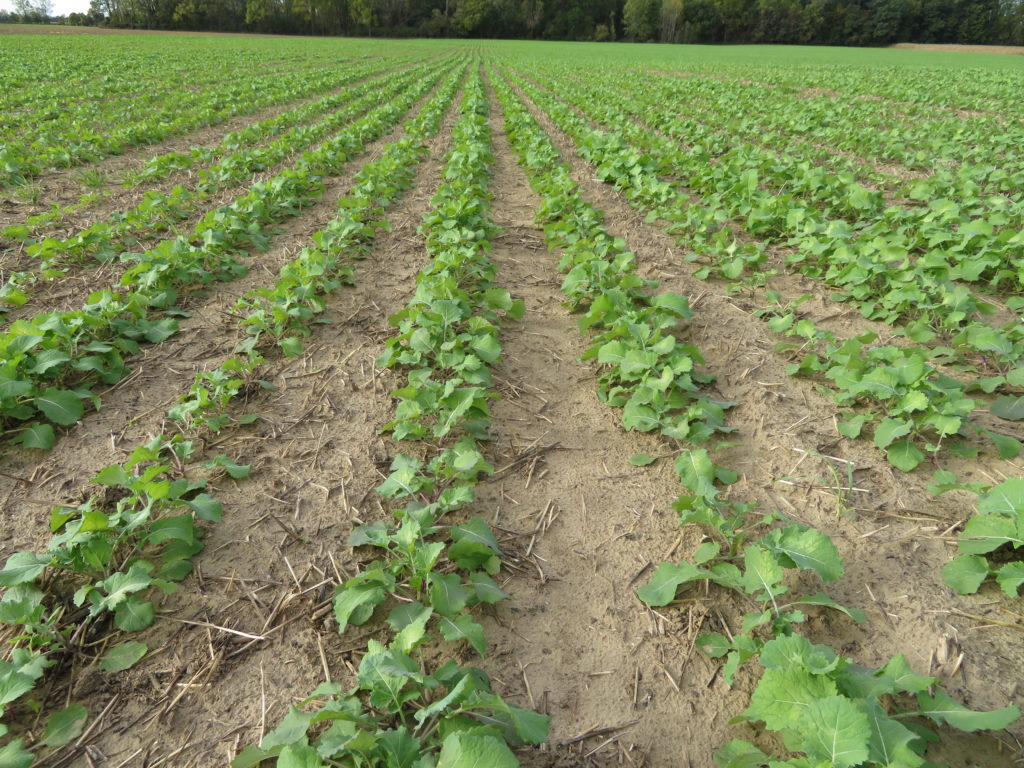Crop Report – Week of July 8, 2024

Rain 360© unit applies watery manure to a standing crop of corn (Photo source from Glen Arnold-OSU). […]

Rain 360© unit applies watery manure to a standing crop of corn (Photo source from Glen Arnold-OSU). […]

Nodulation and Nitrogen Use in Dry Beans In late June, adzuki beans that had been in the ground for 3 weeks already had a few nodules on the roots (Figure 1), and the nodules were active (pink inside when split open). Another field of adzuki planted in the same region around the same time did […]

No-till corn planted into wheat stubble. Photo taken June 25, 2024 near Warkworth in Northumberland County. […]
This article was originally written by Joel Bagg in 2012. It was edited June 27, 2023 by Christine O’Reilly to reflect current insecticide options to control potato leafhopper and the cessation of third-party alfalfa variety trials in Ontario. Potato leafhopper (PLH) is the most damaging alfalfa insect pest in Ontario in most years. While the […]

Co-authored with Albert Tenuta, Pathologist, Field Crops and Peter Johnson, Agronomist, RealAgriculture Fusarium Head Blight Management Managing Fusarium head blight (FHB), also known as scab, in wheat is crucial to prevent yield loss, reduce mycotoxin contamination and maximize grain quality. Identification Fusarium Head Blight (FHB) symptoms are noticeable soon after flowering. Diseased spikelets (glumes and […]

Winter canola harvest will be happening soon in the southern counties of Ontario. Some producers and the researchers at AAFC Harrow have already applied a pre-harvest herbicide last week. Here are some resources on staging the crop for harvest. Resources from Canola Council of Canada and Kansas State U have been used to develop this […]

Seedling waterhemp at the 2 to10 leaf stage in 6 leaf corn. Control must be prioritized since herbicide effectiveness will be reduced as this weed gets bigger. […]

Reproductive 10% flowering 10% flowering is when 10 flowers are open on the main stem. Flowering begins on the main stem, with the lowest buds opening first and flowering continuing upward. Three or more flowers open per day. At first flower the stem is 30-60% of its maximum height. Management: Monitor for cabbage seedpod weevil […]

Vegetative/Reproductive Overwintering Growth resumes when average temperatures reach 5°C but will be slow until it is consistently warm. Leaves may have rotted off or be discoloured but the centre of the rosette should be green. Determine the population of healthy plants. 5 plants/ft2 or more is ideal. 3-4 plants/ft2 is acceptable. 1-2 plants/ft2 can be […]

Vegetative Emergence The hypocotyl pulls the cotyledons above the soil surface. The growing point is exposed between the two cotyledons. Management: Fertilizer in the seed row can injure seedlings, especially nitrogen and potassium. Apply up to 1/4 of total nutrient requirements pre-plant. Seed 0.5-1 inches deep, or a maximum of 1.5 inches into moisture. Broadcast […]

When spring arrives, winter canola growers will have to scout their fields and answer 3 questions before applying fertilizer: Is the canola alive? Does it have strong yield potential? What is the population of healthy plants? Scouting typically begins towards the end of March when plants start to green up. Assessments should be made after […]

Winter canola seed sales have been very strong and Ontario acres in 2020 are expected to be higher than ever before. While research on the crop has been limited, some recommendations are outlined below based on experience over the past few years and experience with spring canola in Ontario. Field Selection Fields should have good […]

Spring canola harvest is not yet complete, with a majority of the crop still standing in northern regions. Many fields were ready to harvest up to two weeks ago, but the weather has not cooperated. Producers are now reporting that canola is re-growing and quite green in the lower canopy. Pre-harvest herbicide application may improve […]

Producers interested in growing winter canola should consider the herbicide history of their field, and the herbicide options open to them following winter wheat harvest. There are a number of restrictions, and some herbicide labels do not mention safety on canola. At this time there is only one winter canola variety that is registered in […]

In the summer of 2016, clubroot disease was found throughout a field of canola in the Verner area of West Nipissing. Clubroot has been established in Brassica vegetable crops in Ontario for a number of years, but this was the first time the disease was confirmed in Ontario canola. Above ground symptoms of clubroot include […]